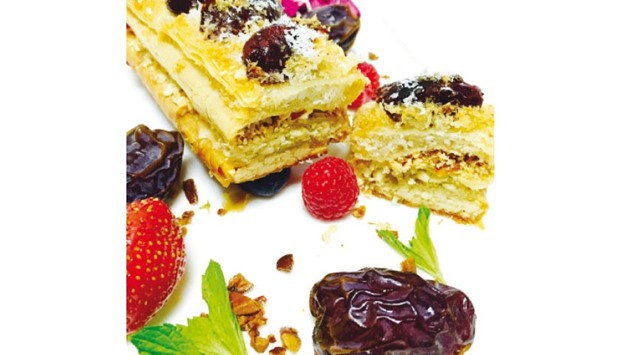Baklava or baklawa, no matter how you spell it, is a rich nutty, flaky, sweet pastry that has always been associated with the spice roads of Middle East. Baklava’s origins are intrinsically tied to the history of the region.
It is a well-known dessert worldwide and is considered a national dessert in many countries such as Lebanon, Turkey and Greece and they all claim partial ownership of this delicious dessert. During Ramadan, you can always find Arabic sweet shops filled with variety of baklava in their varied shapes and fillings arranged in huge dessert platters. These shops are always flocked with sweet lovers to satisfy their sweet cravings.
The story of baklava dates back to 8th century when the Assyrians layered thin dough sheets with nuts and baked their primitive pastry in wood fired ovens and sweetened it with honey. The area was frequented by Greek seamen and thus the dessert travelled to Athens. The Greeks then mastered the art of rolling the dough sheets into paper thin sheets and called it “Fillo”. The word “Fillo” or “Phyllo” actually means leaf in Greek language. The thinner the rolled dough, the crispier the dessert after baking.
In the early days, baklava was served in wealthy households for special occasions due to the high cost of production and limited availability. As often happens with specialty foods, the neighbouring areas and countries adopted and altered the recipe according to their preference and taste buds. So baklava also underwent several changes — Armenians added cinnamon and cloves to their recipe, Arabs added rosewater and cardamom. This mixing of culinary culture and preferences resulted in the modern day varieties of baklava. There are more than a dozen variants available nowadays.
Western European countries also had a similar product called puff pastry. But this dough, which began to be eaten in France during the seventeenth century, differed from its Middle Eastern counterpart as butter was kneaded directly into the dough during its preparation as opposed to the melted clarified butter layering in baklava. Baklava mainly contains nuts as its filling and is always sweet, whereas puff pastry fillings can be sweet or savoury and can contain vegetables to meat items to nuts as their fillings.
To make this delicious pastry in those days was a cumbersome activity involving hand rolling of several sheets of pastry to paper thin thickness and then filling them with choice of nuts. However with the advancement of food technology, readymade fillo pastry is readily available now, which can be easily prepared and filled with nuts in several shapes to make baklava easily. The taste of baklava mainly depends on the thin dough sheets and Middle Eastern chefs still prefer to roll their dough sheets to make baklava rather than buy the readymade fillo pastry sheets. However to make baklava at home, fillo pastry is an excellent option to consider.
The following recipe is one of my latest signature recipes and I call it rainbow baklava because it contains seven types of nuts corresponding to the seven colors of rainbow. Each nut has its own taste and they complement each other when combined together.
Rainbow Baklava
Ingredients
Fillo pastry 500 gm (1 packet)
Chopped almonds 150 gm
Cashew nuts 150 gm
Pistachio 150 gm
Pine nuts 50 gm
Walnuts 50 gm
Hazelnut 50 gm
Macadamia 50 gm
Ghee 300 ml
Rose water 2 tbsp
Cardamom powder ½ tsp
Coconut powder 50 gm
Sugar syrup
Water 1 lit
Sugar 1 kg
Lemon juice 1 tbsp
Method
Crush all the seven nuts mentioned to a coarse texture and keep in a clean dry bowl.
Add rose water, cardamom powder and mix to combine.
Prepare a sugar syrup by boiling sugar with water and adding lemon juice after boiling to clear it, keep aside.
Allow the fillo pastry to thaw and open the sheets, separate a sheet and brush melted ghee all over.
Place another fillo sheet on top, repeat the same to get 6 sheets of layered fillo.
Place the prepared nut filling on one side and roll over to cover the filling to form a cylinder.
Cut along the side to separate from the rest of the sheets.
Place in a greased tray and repeat with the remaining filling and fillo pastry.
Once all the fillo pastry is rolled with the filling inside, brush the remaining ghee on top.
Place deseeded dates on top and sprinkle coconut powder on it.
Cut the baklava into desired length all the way till the bottom layer so that you can separate it after baking.
Bake in a pre-heated oven at 160 Celsius and bake for 40 minutes or until the top becomes crispy and golden in colour.
Remove from oven and pour adequate sugar syrup on top to sweeten the dish.
Allow to cool and serve as required.

